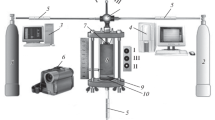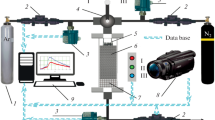Abstract
The combustion of Ti-C mixtures of bulk density under inert gas blowing conditions produced by evacuation of one end of the reaction cell was studied for the first time. The experiments showed that the tested mixtures in quartz cups were not ignited and did not burn without the inert gas (argon) flow. Increasing the rate of gas evacuation from the sample increased the rate of steady-state combustion of the mixture of titanium with carbon black, and for the mixture of titanium with graphite, stabilization of the flat combustion front was observed. It is shown that the presence of small pressure difference (up to 105 Pa) allows control of the combustion process and confirms the basic postulates of the convective-conductive theory of combustion for heterogeneous condensed systems.
Similar content being viewed by others
References
A. G. Merzhanov, Solid-Flame Combustion [in Russian], ISMAN, Chernogolovka (2000).
A. G. Merzhanov and I. P. Borovinskaya, “Selfpropagating synthesis of high-melting inorganic compounds,” Dokl. Akad. Nauk SSSR, 204, No. 2, 366–369 (1972).
V. M. Shkiro and I. P. Borovinskaya, “Combustion of mixtures of titanium with carbon,” in: Combustion in Chemical Technology and Metallurgy [in Russian], Chernogolovka (1975), pp. 253–258.
Z. A. Munir and U. Anselmi-Tamburini, “Selfpropagating exothermic reactions: the synthesis of hightemperature materials by combustion,” Mater. Sci. Reports, 3, Nos. 7–8, 277–365 (1989).
V. K. Prokudina, V. I. Ratnikov, V. M. Maslov, et al., “Titanium carbide technology,” in: Combustion in Chemical Technology and Metallurgy [in Russian], Chernogolovka (1975), pp. 136–141.
B. S. Seplyarskii and S. G. Vadchenko, “Role of convective heat transfer in gasless combustion (for combustion of the Ti+C system),” Dokl. Ross. Akad. Nauk, 399, No. 1, 72–76 (2004).
B. S. Seplyarskii, “Nature of the abnormal dependence of the burning velocity of gasless systems on diameter,” Dokl. Ross. Akad. Nauk, 396, No. 5, 640–643 (2004).
A. G. Merzhanov, A. S. Mukas’yan, and S. V. Postnikov, “Hydraulic effect in gasless combustion,” Dokl. Ross. Akad. Nauk, 343, No. 3, 340–342 (1995).
A. F. Belyaev, B. K. Bobolev, A. I. Korotkov, et al., Deflagration-to-Detonation Transition for Condensed Materials [in Russian], Nauka, Moscow (1973).
A. P. Aldushin and B. S. Seplyarskii, “Propagation of an Exothermic-reaction wave in a porous bed with gas blowing,” Dokl. Akad. Nauk SSSR, 241, No. 1, 72–75 (1978).
Author information
Authors and Affiliations
Corresponding author
Additional information
__________
Translated from Fizika Goreniya i Vzryva, Vol. 45, No. 1, pp. 30–37, January–February, 2009.
Rights and permissions
About this article
Cite this article
Seplyarskii, B.S., Vadchenko, S.G., Kostin, S.V. et al. Combustion of Ti+0.5C and Ti+C mixtures of bulk density in inert gas coflow. Combust Explos Shock Waves 45, 25–31 (2009). https://doi.org/10.1007/s10573-009-0004-x
Received:
Revised:
Published:
Issue Date:
DOI: https://doi.org/10.1007/s10573-009-0004-x




